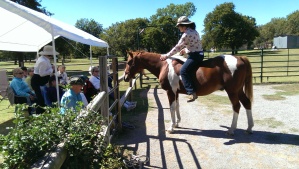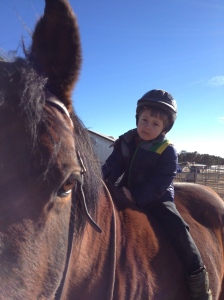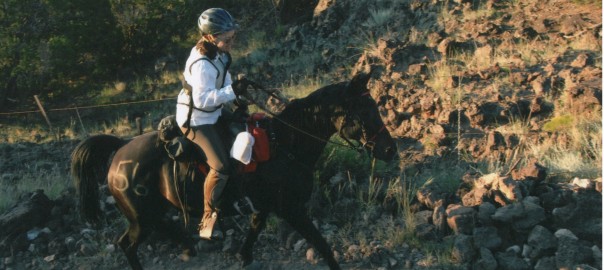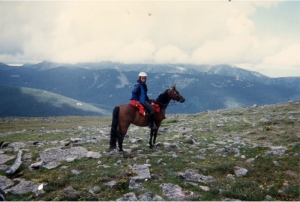Recently there has been a lot of attention in the horse press given to whether it’s best to ride a horse with a saddle or not, or even whether to ride horses. This query also extends to whether we should all ride our horses in a neck rein or bitless bridle, are all bits cruel, etc.?
I will reply to these questions with my own ideas on the subject, formulated after many miles of riding both competitively and for pleasure, and the experiences of my students and myself as a teacher.
I’m not a riding instructor, other than to teach my grandchildren to ride. This gives me an opportunity to take them from the study of the Foundations where they learn to have a special relationship with a horse, to the saddle ultimately, where they can continue that relationship as a “centaur.” In the beginning they ride bareback. When we advance to the trail they need to use a saddle. They ride with no bit because they don’t know how to use one. They learn by doing this how to give the horse signals with their body, voice and the rein. Ultimately, they will learn to be in sync with their horse.
Novice adults are often impatient and expect that they should be able to ride. If they have visited a dude ranch, their experience is that someone tacks up the horse, they get on and get led out on a trail by a wrangler. They don’t have to know anything. Later when they might buy their own horse, they want that same experience. Guess what? Even if they buy a dude string horse, that horse is likely not going to behave the same way it did in a dude string. Owning a horse might quickly feel like too much work.

At Horses at Liberty Foundation Training we can take you to riding without saddles because that is an example of what you can do with your horse if you want to go there, if the horse is a willing partner in this. I certainly wouldn’t recommend riding for a long time without a saddle because it might be painful for you and the horse, and you might not have as good balance as you might think you do and fall off. Bareback doesn’t give you much to hang onto if your horse should spook. Bareback also doesn’t distribute the rider’s weight well enough for a long ride. For children learning to ride or young adults, bareback is a great way to get connected and to learn to move your hips with the horse’s body. A lot of riders are too stiff in the pelvis from only riding with a saddle, or not translating that horse sway to their own bodies.

Older riders who aren’t used to bareback will be safer with something to hang on to, unless they have a horse that doesn’t move much.
We see people riding bridleless in competitions, and just for pleasure. Bridleless can mean with a neck rein or with only a halter or bitless bridle. Although this is very popular, it isn’t always practical. Some horses go well in this way and others don’t. It also depends upon what situation you put the horse in. If you are in an endurance ride, for example, some kind of head gear is a really good idea. And unless you know you can manage your horse in a bitless bridle or less, I wouldn’t ride in one. I remember years ago on a five-day ride there was a guy who had studied some natural horsemanship who rode his horse in a halter. It was one of these methods that insist you ride everywhere in a halter first and then once your horse learned everything he needed to know, he could graduate to a bit. The horse kept running into the back of other horses on the trail because the owner couldn’t stop him. When I heard him thundering up behind me I immediately got out of his way. That’s one way to stop a running horse – run him into another horse! I decided right then and there that unless I could manage my horse in such circumstances, I wouldn’t ride in a halter.
One reason why that doesn’t work so well is that the relationship you have with your horse at home on trails you’re familiar with, may be tested when you get in a competitive situation with other horses. This type of ride makes horses feel like they’re in a herd, and they can forget their riders. They get blank spots. We call it “race brain.” It’s why I like to have that relationship really solid before going on a ride like that, but I also realize that my influence may be small compared with that of a real horse herd running. What I worked out in those situations was to ride with a bridle for at least half the ride, and take the bit off during the last half of the ride when my horse was quite calm. And by the way, this can happen even in a group ride hosted by your local trail club.
I want a horse really responsive to the rein, whatever is on his head, so there is not resistance and pulling. I don’t want to use the reins much, just as a way to maintain contact with the head. The problem with a bit is it’s a piece of metal in the mouth and could hurt the horse if the rider pulls too hard. The problem with a bitless bridle is it puts pressure on the sensitive part of the nose and/or head. The problem with a neck rein is it is so non-specific. The type of equipment used must be carefully chosen for the horse, and the rider’s ability. What it really comes down to is that you are best able to do no harm to the horse while riding if you have a good education. It’s not so much about the equipment used as what you do with it. More importantly, it’s more about the relationship you form with the horse you are going to ride. As I continue my study of the relationship in the saddle (or without one) I find myself slowing down to enjoy incremental shifts; how do I move with the horse over here, or there, how do I convey what I’d like to do? How do I remain a non-interfering and supportive element in the relationship between horse and rider? And ultimately, how can we be horse and rider together, as one, like a centaur?
-

Jacque and her mare, Gracie To work with the relationship between horse and rider, we can start with the Foundations. We can also intersperse Horse and Rider work to make sure the physical connection between the two is comfortable. If the horse has physical limitations we can work with that too. As I age, I must have a connection where I am safe and I’m not putting too much stress on my body, hence I won’t get into a resistance battle with a horse. The horse must be a willing partner. I expect many people feel the same way, knowing how much damage can be done to themselves and their horses by pulling and tugging. This is where working at liberty with your horse can help to establish a bond that will carry over and increase the communication between the two of you. You also can begin the process of encouraging lightness in your horse.
There are schools of thought that suggest we should not ever ride horses. That there are no saddles that fit horses properly. With the amount of data compiled on saddle fitting and the attention to the saddle industry itself, I would guess that this information is inconclusive. I have spent much time and energy in fitting saddles that do not cause pain in the horse that, and I have ridden long distances in these saddles without causing soreness.

Because of physical problems or behavior around riding, some horses may be better off never being ridden. But I think in general, horses enjoy the connection with people in or out of the saddle, as long as the people are cognizant of saddle fit and other concerns that come about for the saddle horse. I know from experience that some horses will ask you to get on their backs. I also have experienced the deep working bond that has developed with a horse that you are riding, day in and day out, for mile upon mile, taking care of one another, syncing your breaths and patterns, on new and interesting terrain. A horse can take an avid interest in a human goal if she has a say in the matter, and the activity is one that she takes real joy in and can accomplish physically and mentally without pain or stress. Pick the activity and timing and saddle/bridle combo that best suits your horse, and the rest is all attention and energy.
Services: Bodywork (Ortho-Bionomy for people, Equine Positional Release/Equine Ortho-Bionomy): private sessions (including Horse & Rider sessions), tutorials, phone consultations, distance healing communication and gift certificates
Liberty Training: clinics, mini-clinics, workshops, private and semi-private sessions, tutorials, consultations: by appointment: 505.501.2478 or emailing susansmith@orthohorse.info
Fall Lessons – semi-private, private and small group sessions. Scheduling now. We have small groups and privates scheduled for Santa Fe, Corrales and El Dorado currently. Contact me for details.
OrthoHorse Tutorials and Horses at Liberty Foundation Training Clinics will be offered on the 2014 schedule.
Fascinating article on Ortho-Bionomy: Better than a pain pill? PostIndependent.com
Copyright (c) Susan Smith, OrthoHorse, Horses at Liberty Foundation Training





This is really good! Good idea to send it out as email. I need to get a list together, too.
Ruella Yates Training Horses at Liberty http://www.libertyfoundations.com/ T
________________________________
________________________________
I ride bitless in southwest Missouri and can control my horse from running into almost anything. If we have a rider come off or some circumstance where my horse spooks, I know how to get him under control. And, as long as I am on him, I can get him under control with the techniques he already knows. We have had successful trail rides for years now, not extremely large ones and not all day. But, I feel confident that because of the ground work we do and the knowledge I have of his personality, he will calm down and we can continue. It is not just natural horsemanship we use today, it is so much more. I also feel this article makes it a foregone conclusion that it is inevitable that all horses need the bit. Bits hurt, cut, and numb the mouth, horses can learn how to use pressure to counter the rocking and pulling on the reins for their own relief. This is counterproductive to riding this horse in the future. Race horses will sometime take the bit and then the rider has no control at all. It is time for EVERYONE to get educated on horses before they ride. I agree that all horses are different and some need a bit. NOT ALL. We have successfully trained two horses younger than 6, to ride bitless after being used to a bit. They love it and their owners do too. It also depends on the human and their level of connection. Many people don’t want a relationship and just want to ride. Some humans want so much more and those are the ones that I hope read this comment.
Thank you for your comment and sharing your experiences with your horses, Debbie. I did not mean to suggest that it is a foregone conclusion that all horses will need a bit, quite the contrary. I was sharing my experience with endurance riding, riding at speed with a lot of other horses. In that setting, I often did need a bit, but I didn’t always use one. When you need to stop a horse, even when you are a good rider and have a good relationship, it’s important to be able to stop the horse for your own safety. Now, I use a bit sometimes only with one horse; the other three are all bitless. I was actually trying to make the point that building a relationship is the best foundation for riding, and then you can make a better decision about what equipment to use once that’s established. Horses vary in their responsiveness also. I want to develop their responsiveness and lightness so we can move beautifully together. I agree that there are more people who are not interested in taking the time it takes to develop this; they simply want a horse to get on. It would be wonderful if everyone wanted to be educated.